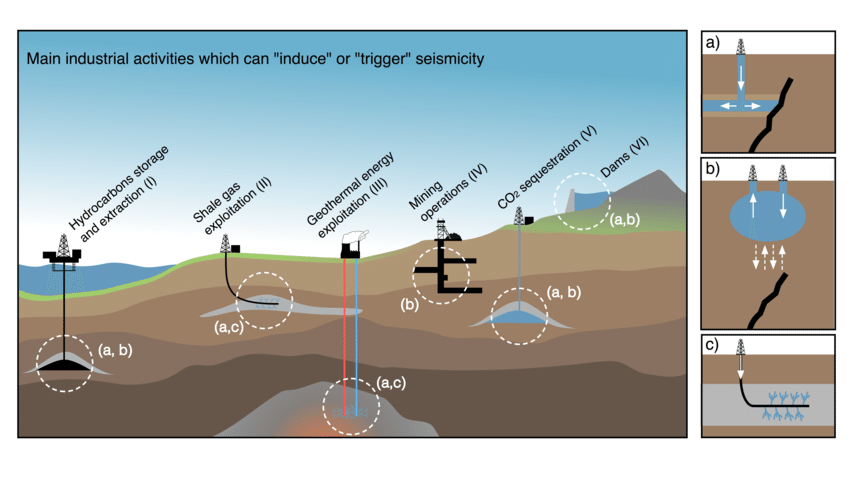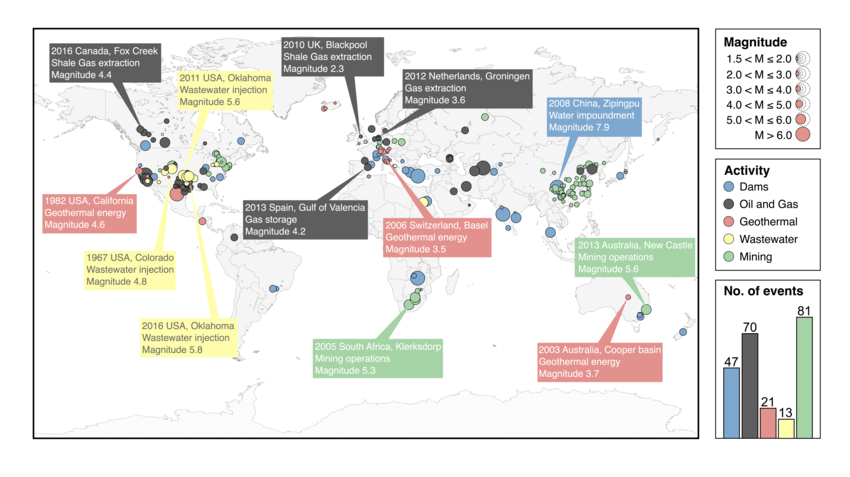What does the term induced seismicity mean?
Among the different societal impacts of industrial activities related to the exploitation of geo-resources, one that recently caused particular public concern is the “Induced seismicity”. With this term we usually denote the seismic activity directly or indirectly caused by such industrial operations.
The first observations of the induced seismicity phenomenon date back to the beginning of the twentieth century, in relation to coal mining operations. However, only after 2009 with the sharp increase of seismicity associated with wastewater disposal operations in the US, the topic started to receive considerable attention by the public [1]. In general, every industrial activity that alters the stress state within the Earth’s crust might induce or trigger earthquakes. The most common operations related to induced seismicity besides wastewater disposal are underground mining, water reservoir impoundment, oil and gas production (from both conventional and non-conventional resources), geothermal energy exploitation, and natural gas storage operations. These industrial activities (figure 1) can alter the subsurface’s stress field by pore pressure changes (a) or volume and/or mass changes (b). In the first case (figure 1a), the increase of pore pressure triggers the earthquake by reducing the effective normal stress on the fault. This requires a high permeability pathway between the injection well and the fault. In the second case (figure 1b), the earthquake is triggered by a change in the shear and normal stress acting on a fault. In this case, no hydrological connection is required [1]. Seismicity associated with hydraulic fracturing operations (figure 1c) is generated by the tensile cracks due to high-pressure fluid injection in impermeable shale layers. Here, the fluid injection process completely drives the rupture process, which starts when the fluid pressure overcomes the minimum principal stress of the in-situ stress field. In general, the probability of induced and/or triggered seismicity is directly related to the entity of the stress alteration and/or to the closeness of seismogenic faults nearby the industrial site.
Since underground industrial operations in highly populated regions have increased in the recent past, also the amount of felt earthquakes suspected (or considered) to be related with human activities raised significantly [2]. As depicted in figure (2), induced earthquakes are globally distributed. The largest number of events correlate with mining operations, while the largest induced events in terms of magnitude resulted from water impoundment.
Triggered: system already loaded. The EQ generates more energy than the energy brought into the reservoir by the fluid injection.
Induced: Stress accommodation due to the energy brought into the reservoir by the fluid injection.
Why do we need to monitor induced seismicity?
Induced seismicity monitoring is extremely important to obtain and better understand the physical processes governing this phenomenon. It also allows identifying and mapping potential active faults nearby industrial sites. Such information is extremely important for risk assessment operations, which one should carry out before the start of any operation [2]. Fluid injection and extraction in tectonically active zones carry a significant risk to induce a seismic event of a significant magnitude [1]. Several attempts tried to reduce the probability of the occurrence of damaging earthquakes triggered by these operations. In this context, the most widely used tool for hazard management in many geo-energy exploitation operations is based on monitoring induced seismicity real-time – the so-called “traffic light system”.
This system is a threshold-based method, which relies on three main observations: 1) public response, 2) observed local magnitude and 3) peak ground velocity. In a four-stage action plan, the injection of fluids would either be 1) continued as planned (green); 2) continued but not increased (yellow); 3) stopped (orange) or 4) stopped and a “bleed-off” initiated (red). However, in some previous cases, this system did not work properly since the largest induced events occurred after shutting down the injection/extraction operations (e.g. Basel (Switzerland) geothermal power plant, Blackpool (UK) shale gas exploitation and the Castor project (Spain) offshore gas storage). This revealed that we are still far from the solution to this problem [2].
How can we monitor induced seismicity?
Microseismic networks are key tools to monitor induced seismicity. Technical specifications of a microseismic network to ensure optimal monitoring conditions are still under debate and not yet standardized [2]. The performance of a microseismic network depends on many factors, including sensor type, number of stations, network geometry, instrumental and ambient noise level. Furthermore, the desired performance on detection and location of an induced seismicity monitoring infrastructure is strongly dependent on the type of application. Therefore, it should be designed in synergy with a risk assessment and site characterization phase, for the cost-benefit optimization. The detection capability of the network, which is related to the magnitude of completeness Mc, is dependent on the application and should consider the seismic hazard, background seismicity and the Mc of the national/regional seismic network in the area. The accuracy of the location performance is important to understand ongoing seismic processes (e.g., to map the spatio-temporal evolution of the seismicity which could reflect fluid migrations). In addition, it is a fundamental information to discriminate between natural and induced seismicity. However, the desirable location uncertainty remains intrinsically linked to the type of operations and potential hazard. For instance, locations that are more precise ensure the integrity of reservoirs or accurate mapping of fractured and more permeable regions [68]. The location performance is not only controlled by the geometry and technology of the monitoring infrastructure, but also on the adopted methodology and on the available velocity model. The latter is generally the largest source of error in the seismic event location process. Therefore, tests with synthetic simulation and real data remain the best practice to assess the location performance of the network. Dense networks with at least one station (better if deployed in a borehole) directly above or within few kilometers from the potential source of seismicity (e.g. injection well) can further reduce location uncertainty. Finally, some traffic light systems require, among different input parameters, the Peak Ground Acceleration (PGA). In these cases, the presence of strong motion sensors within the microseismic monitoring infrastructure is extremely important.
How can we solve the problem of induced seismicity?
To tackle the problem of induced seismicity, a comprehensive risk governance strategy must include a suitable monitoring infrastructure, sophisticated data analysis techniques for real-time seismicity characterization, quantitative risk analysis, and transparent decision protocols. All these elements combined would help to evaluate the system response before the occurrence of critical events, allowing a risk mitigation strategy to be implemented in advance.

Figure 1: Industrial activity which can “induce” or “trigger” seismicity and related physical mechanisms (modified from [2])

Figure 2: Global distribution of documented cases of induced seismicity (updated to 31/08/2016), classified by magnitude and type of activity. The colored boxes contain informations on the most relevant events (from [2]).
References
[1] Ellsworth, W. (2013). Injection-induced seismicity, Science, 341.
[2] Grigoli F., Cesca S., Priolo E., Rinaldi A. P., Clinton J., Stabile T. A., Dost B., Garcia-Fernandez M., Wiemer S., Dahm T. (2017). Current challenges in monitoring, discrimination, and management of induced seismicity related to underground industrial activities: A European perspective, Reviews of Geophysics, 55(2), 310-340, doi:10.1002/2016RG000542
[3] Shapiro, S., O. S. Kruger, and C. Dinske (2013), Probability of inducing given-magnitude earthquakes by perturbing finite volumes of rocks, J. Geophys. Res. Solid Earth, 118, 3557-3575, doi:10.1002/jgrb.50264.
[4] Dahm, T., Cesca, S., Hainzl, S., Braun, T., and Krueger, F. (2015). Discrimination between induced, triggered, and natural earthquakes close to hydrocarbon reservoirs: A probabilistic approach based on the modeling of depletion-induced stress changes and seismological source parameters. Journal of Geophysical Research: Solid Earth, 120(4), 2491-2509.
[5] Dahm, T. et al. (2013). Recommendation for the discrimination of human-related and natural seismicity. Journal of seismology, 17(1), 197-202.
[6] Maxwell, S. C., Rutledge, J., Jones, R., and Fehler, M. (2010). Petroleum reservoir characterization using downhole microseismic monitoring. Geophysics, 75(5), 75A129-75A137.
[7] Fehler, M., Jupe, A., and Asanuma, H. (2001). More than cloud: New techniques for characterizing reservoir structure using induced seismicity. The Leading Edge, 20(3), 324-328.



